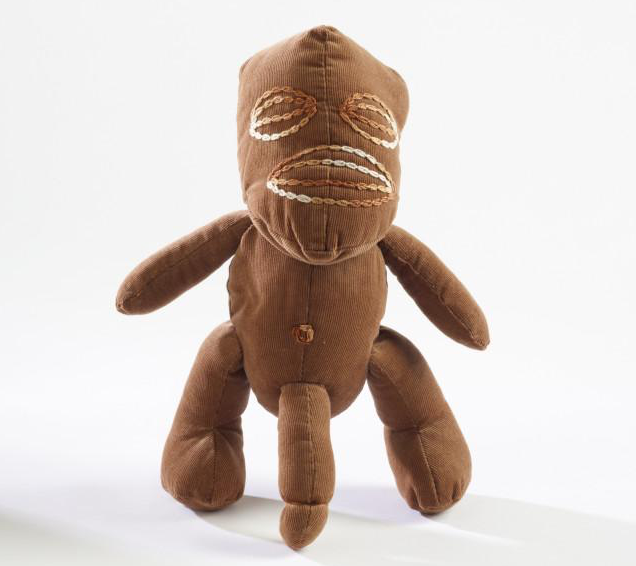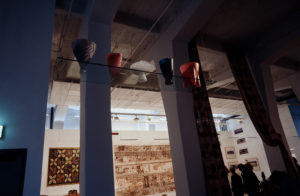ARTISTS Fatu Feu'u, William Furneaux, Patriq Futialo, Bruce George, Niki Hastings-McFall, Ioane Ioane, Lily Laita, Iosefa Leo, Simmie Nichols, Johnny Penisula, Lyle Penisula, Laugutu Poloai, John Pule, Ani O'Neill, Albert Refiti, Toegamau Tom Sefo, Greg Semu, Tania Short, Filipe Tohi, Michel Tuffery, Lape Fakalaga Tulisi, Veronica Vaevae, Loretta Young CURATOR Jim Vivieaere OTHER VENUES Auckland City Art Gallery, 2 December 1994–6 February 1995; Manawatu Art Gallery, Palmerston North, 14 April–27 May 1995; Waikato Art Gallery, Hamilton, 10 June–20 August 1995; Robert McDougall Art Gallery, Christchurch, September 15–29 October 1995
Bottled Ocean is an exhibition of contemporary Pacific Island art that seeks to problematise the idea of ‘Pacific Islandness’ and the desire to ‘bottle’ it.
Curator Jim Vivieaere, an artist of Rarotongan descent, showcases twenty-three artists—twelve Samoans, five Cook Islanders, four Niueans, and two Tongans—most second-generation New Zealanders. Their works range from designer Simmie Nichols’s corrugated-plastic lamps and Loretta Young’s printed curtains to Iosefa Leo’s carved Hinuera stone heads to John Ioane’s conceptual installation of a canoe jutting out of a fireplace, Magritte-a-Nui—a play on Rene Magritte's famous painting Time Transfixed. Well-known artists, like Fatu Feu’u, Michel Tuffery, John Pule, and Lily Laita, are positioned alongside newcomers, like Ani O’Neill (a recent Elam graduate) and Niki Hastings-McFall (a Manakau Institute of Technology student). Vivieaere tells the Listener, ‘the artists I chose didn’t know my agendas, and I wasn’t looking for work that looked Polynesian’.
Drawing attention to cultural stereotypes and expectations of the exotic other, Vivieaere displays several works on a mirrored mylar floor behind a Perspex screen, mimicking the conventions of both museum and shop-window displays. He says, ‘as guest curator I’m exploring this uneasiness around the Pacific Island identity and the collusions between assumed heritage and urban experience’. Vivieaere’s curatorial decisions are often perverse. Michel Tuffery is famed for his printmaking (and for his logo for the 1994 International Festival of the Arts), but, rather than show his prints, Vivieaere exhibits the woodblocks themselves (Coconut, Coconut). Vivieaere intends the show be experienced as an installation, so there are no work labels or works list. Instead, artists’ names pass across a LED display, as used in shops and stock exchanges. Wayne Laird’s Pacific Ocean soundscape plays throughout. In Art Asia Pacific, Wendy Vaigro calls the show a ‘meta-exhibition’.
The most discussed works are Tuffery’s life-size bull made from corned-beef tins, Pisupo Lua Afe (Corned Beef 2000), and Ani O’Neill’s twelve cuddly corduroy Tangaroa dolls, which rest on their legs and oversized penises. Tuffery’s bull is emblematic of the impact of global trade on Pacific Island cultures, where imported corned beef has become crucial in feasting and gift giving. Tuffery produced this breakthrough piece specifically for the show; it is now in Te Papa’s collection. The bull and the Tangaroa dolls, confront the viewer from behind the Perspex screen, like tourist merchandise.
Bottled Ocean tours to many other New Zealand galleries. Vivieaere alters the layout each time, adding and subtracting works and artists as pieces are sold. In the second iteration of Bottled Ocean, at Auckland Art Gallery, he displays several works partly unpacked. Tuffery’s woodblocks are shown in a stack, still encased in bubble wrap. There, he also displays other packing materials featuring Exhibitour stickers, artists’ statements, and responses to the Wellington show. He tells the Herald, the ‘only reason we are here is that we are Polynesian—not on our merits but because we’re the “other” ... We don’t need Polynesian shows. I would like to see it as the last.’
Anthropologist Nicholas Thomas becomes a key figure in the show’s reception. At City Gallery, he presents a lecture, ‘Pirating the Pacific’. Interviewed by the Evening Post, he says, ‘A lot of the artists have had art school training, which means it’s a new kind of Polynesian culture which belongs here, rather than in the islands.’ He reviews the show for Art New Zealand and writes on it for The Contemporary Pacific, a journal published by University of Hawaii Press.
In the 2012 book Art in Oceania: A New History, Peter Brunt writes: ‘Bottled Ocean made the “arrival” of contemporary Pacific art in the elite galleries of the New Zealand art world a problem to be reflected upon, rather than simply a triumph to celebrate. Having been invited to survey the work of Pacific migrants, Vivieaere turned the exhibition into something of an installation, a work of art in its own right, in which he used various exhibitionary devices to make the desire for “cultural difference” and “otherness”, which had become broadly topical in the art world, the implicit subject of the exhibition.’














































































